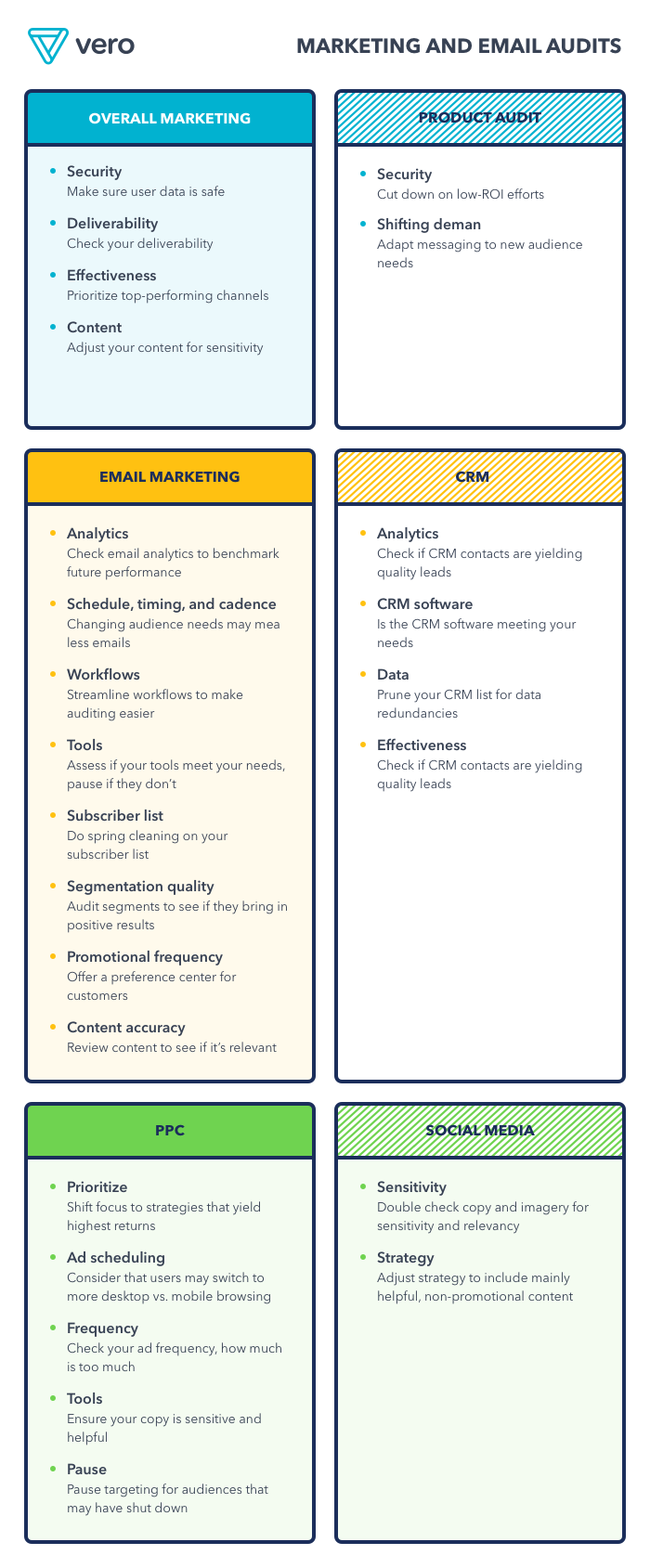
Auditing your marketing and emails during a crisis
-
Messaging and AutomationUpdatedPosted:
On this page
At the time of writing, there’s uncertainty and challenges abound. People around the world are dealing with the Coronavirus (COVID 19), and your marketing plans for the year may be on hold.
The type of audit we’ll cover is helpful in any sort of crisis, though. You may find yourself here if there’s a recession, or if your company is experiencing a rough patch.
It’s always important to be respectful and supportive of your audience, and in times like these, you’ll want to pay extra close attention to your outgoing marketing. While times are tough, there’s a silver lining.
This is a prime opportunity to take a deep look at your workflow and prune processes or tools that aren’t serving you as well as they did in the past.
Knowing where to start with a marketing and email audit is challenging, especially when you’re also dealing with the crisis in your personal life. To make your review process as easy as possible, we’re going to break down what you should be doing, step by step.
The areas your marketing audit should cover
While each channel has specific considerations when performing an audit, there are high-level aspects of your marketing that you can check across all tactics.
Here’s a framework for reviewing your strategy during a crisis
Security
Making sure your customer data is safe and secure is critical, particularly during uncertain times. Your audience may already be feeling anxious, and you want them to know that you have their best interests at heart.
Check your security settings and protocols to make sure you don’t accidentally add a breach to your user’s list of things to worry about.
Deliverability
As events unfold and new details emerge, you want to make sure that important updates are making it to inboxes. Check your email reputation to make sure your IP address and domain are still in good standing with inbox providers, and that you aren’t on any spam filter blacklists.
If you notice an issue with your email reputation or need to double-check, you can use deliverability testing tools. Sites such as 250ok and Return Path give you peace of mind that your emails are staying out of spam.
Effectiveness
Your promotional strategies may change during a crisis, but you should still monitor marketing effectiveness. Compare the results of your email, push notification, SEM, social ads, and more to how they’ve converted in the past. Which subject lines are leading the way at this time? How is your audience reacting to existing messaging.
Now is also the perfect time to identify your top-performing channels and campaigns so that you can pause the rest if needed while still propelling your company forward.
Content
The previous measures have all been analytical or easily measured, but this audit category needs a human touch. You need to review your content and positioning to make sure there’s nothing that could be perceived as insensitive or tone-deaf.
As an example, beauty brand The Creme Shop posted that they would be donating N95 masks to health care workers, which is admirable. Their efforts toed the line of self-serving, though, when they shared a coupon code you could use to receive a free mask with each purchase.
Navigating promotions during a crisis is tricky, and you can look to other brands for guidance on what and what not to do.
Review all of your copy to make sure it’s positive, helpful, and considerate. Empathy is impactful and appreciated in uncertain times, as is relevancy!
Tools
Uncertainty often makes you think twice about your budget, and you can use this time to review your tools and subscriptions. Make a list of all of your software subscriptions and think about who uses them, how each team uses them, and how often you log on.
If you find that you’ve abandoned or severely cut back on some tools, and you can pause your account. Don’t be too quick to cancel under-used tools, though. During your review, you may find additional capabilities that you can start using now. Think of it as making the most of what you have.
As a summary:

Auditing each of your marketing channels
Now that we’ve covered the aspects and themes you can apply to all marketing channels, let’s dive into specifics. You can use the marketing audit steps we’ll cover below to tackle your entire cross-channel strategy, preferably starting with your most-used channels.
Audit your product
Each crisis or recession will impact different industries in varying degrees, but it’s always a good idea to re-evaluate your SaaS product.
Here are your two main tasks for auditing your SaaS:
Cut down on low-ROI efforts
If you’re in a recession, or there’s a chance one could happen, you’ll want to think carefully about your budget. Calculate the ROI of different marketing channels and tactics, and consider trimming underperforming strategies.
By prioritizing your most impactful acquisition and retention strategies, you can preserve cash flow without sacrificing growth.
Pay attention to shifting demand
A crisis may make your audience change their priorities and needs. Look at search trends and social media discussions in your niche to notice new perspectives. You may find that you can still serve users’ needs, but it would help to change your messaging and positioning slightly.
You may also identify small additions you can add that would make your product a better fit for the evolving audience.
As a summary:

Email audit
Email is a more direct, personal connection to your audience, and you should treat it with particular care during a crisis. Your email program may also have the most components and moving parts compared to other marketing channels, so you have a lot of details to review.
Analytics and metrics
Start your email audit by understanding how all of your emails have performed, so you can benchmark future performance to when times were normal. Looking at your email analytics also helps you identify the most impactful campaigns, in case you need to pause the rest.
Schedule, timing, and cadence
How often do you usually send promotions and newsletters? As your audience’s attention drifts towards the news and their families, you may want to cut back on email cadences. It’s also considerate to alter email automations to give users more time to act or react before triggering the next email.
Workflow and processes
Auditing your current marketing and potentially pivoting strategies is going to take up a lot of your time, which means you need a streamlined workflow. Make a list of existing stakeholders and processes, and consider whether you can slim any workflows down. Streamlining your email workflow doesn’t mean you should skip out on pre-send testing, though.
Marketing infrastructure and software
While your team will likely be too preoccupied with marketing and email audits to make any significant infrastructure changes, you’ll at least need to assess how your tools meet your needs.
For example, are you approaching send limits on your email service provider? Getting blindsided by a need to upgrade would be an unwelcome surprise in times like these. Similarly, are there any tools or services you haven’t used in a while that you can pause?
Subscriber data quality
While you’re working on your email audits, why not clean up your subscriber list!
Now is the perfect opportunity to do a little “spring cleaning” and make sure you remove hard-bounced email addresses. You may also consider clearing out subscribers who haven’t opened emails in a while, especially if reducing your email size could save you money with your email service provider.
Segmentation quality check
The last thing your subscribers want from you during a crisis is a surge of irrelevant emails. Checking your segmentation, and whether or not they’ve yielded positive results, helps you send more relevant emails. You should also check for any audience or segmentation overlap.
If you find that there are groups of people falling under multiple categories, you need to decide which segments take priority. Cutting down on the number of different segments you’re marketing to can reduce send volume, which could improve engagement percentages.
Promotional frequency
Preference centers that give subscribers the option to tailor email frequency are always good to have. Rather than simply including it at the bottom of every email, you could create a unique “preference center” email. Rather than assuming what your audience wants, you can survey them.
Content accuracy and sensitivity
It can be hard to keep all information up to date when events evolve so quickly, so cut yourself some slack if you make a few human errors. It’s good idea, though, to review outgoing campaigns for accuracy and sensitivity.
Make sure transactional and promotional emails are considerate of current events, and that they’re accurate. Don’t forget about email automations such as birthday discounts, which you could consider extending.
As a summary:

CRM audit
Maintaining relationships through thoughtful support during a crisis can lessen the long-term impact. Your CRM audit measures are focused on cleaning up data and making sure you’re using all of the tools and information at your disposal.
Contact list audit
Do you know who’s on your CRM contact list? No, you don’t need to memorize them all by name. However, you should review how everyone ended up there, and if they all still need a spot on your contact list.
You can also analyze every acquisition source to determine if it delivers quality leads. Sources that aren’t as lucrative should be excluded. In addition to reviewing your contact list, look at who on your team uses the tool, and how.
CRM software audit
While you’re reviewing your CRM and contacts, go ahead and take a look at how the software fits your needs. Are you reaching list size limits on your account? Are there features you don’t use, but would be helpful in this scenario?
Data redundancies or opportunities
Just as you should use this time to clean up your email list, you can review your CRM list for data redundancies. Are you collecting information that you don’t use? Are there multiple listings of the same contact or details?
It’s also advantageous to look for new ways to use the data you already have. Are there insights hiding within your CRM that would be useful for segmentation across other channels? If your CRM doesn’t account for it already, it’s a good idea to make a note of each contact’s industry.
Knowing a person’s industry often helps you send relevant messages, and it also helps you identify impacted industries that may need sensitive handling.
Analytics and effectiveness
When you’re performing an audit because of some world or industry event, you need to set aside any bias you may feel for a channel and evaluate its actual effectiveness. Do activities and insights related to the CRM move your company forward in a meaningful way?
Even if your CRM is useful, is it among your top tools or channels? If it’s not, you may need to put it on the back burner while your attention is elsewhere. If your CRM is indispensable, then figure out how you can lean into it even more.
Compliance
You don’t want to emerge from a crisis only to be met with a compliance issue. Make sure that your data collection adheres to regulation such as GDPR, and that you’re safely managing customer data.
As a summary:

PPC audit
Wondering how to review your PPC ads or do a Facebook ads audit? Your tasks for this marketing channel are all about doubling down on what works, and making sure your copy and creative is empathetic to customers.
Below is an example of a list of Facebook campaigns, with the highest ROI highlighted.

Prioritize high-performing strategies
The first step in auditing your performance marketing in a crisis is reviewing all current campaign performance. Which keywords and campaigns are yielding the highest returns?
You should shift your focus to invest more in keywords, ad groups, creative, and campaigns that have a high return on ad spend and low cost per acquisition. Conversely, pause ads with the highest cost-per-click or cost of acquisition.
Update ad scheduling and device bidding
Worldwide events, such as the Coronavirus outbreak, impact your audience’s daily routine and behaviour. As a result, you may need to update your PPC scheduling and devices. The optimal time of day or days of the week could be different, and your strategy will need to adjust to match it.
Also, more people staying at home could lead to more desktop use, and less mobile browsing. Therefore, it may be worth it to invest more into desktop placements over mobile devices.
Check your ad frequency
If paid ads are a high-performing strategy for you, it may be tempting to double down on them. You need to be mindful of ad frequency, though.
If you cross the threshold with your audience and show them too many similar ads in a short amount of time, you run the risk of annoying potential customers and wasting your budget.
Review copy for empathy
In addition to looking at ad performance, you need to review your ad and landing page copy. Is the information still accurate, and is the tone empathetic to what’s happening?
While you don’t need to sugarcoat reality, try to maintain a positive or hopeful tone. Your copy at this time should help people feel supported. You should also audit your targeted keywords to remove any that are insensitive.
Pause targeting for some audiences
Depending on your business, you may have targeted people or companies that have temporarily shut down due to the crisis. In this case, you’ll want to pause or alter paid ad campaigns for these segments.
For example, gyms, restaurants, and movie theatres that are closed due to the Coronavirus likely won’t be as receptive to promotional ads as they were before.
As a summary:
Social media audit
The final marketing audit to cover is social media. People may choose to check on their social feeds frequently during down time, so you could have increased visibility for your updates. When doing a social media audit, you should look at scheduled campaigns, as well as adjust your strategy for the days ahead.
Check scheduled posts
The first place you should look during your social media audit is your scheduled posts. Check copy and imagery to make sure they’re considerate of the situation and don’t contain any phrases that could be insensitive. You also need to make sure that landing pages are updated, too. When you’re operating in uncertain conditions, it’s wise to keep your planning close. Spending a lot of time to plan a month’s worth of content in advance could be a waste if new information is released and you need to pivot your strategy again. Planning your work and creating posts only a week in advance keeps you nimble.
Adjust positioning and promotion
Campaigns that blatantly ignore the uncertain times and continue promoting products normally could come off as pushy. In addition to promotional posts, make sure that you adjust your strategy to share helpful content. Any promotional content you do post should focus on how people can leverage your products or services to help with their situation.
As a summary:

When there’s a crisis, it’s easy to feel panicked or wonder if drastic measures need to be taken. However, you can create the best next steps when you take calm and calculated steps to audit your current and upcoming marketing. Above all, empathy and compassion go a long way in uncertain times.
Want to learn more about marketing during the Coronavirus? We’ve rounded up some messaging trends, as well as marketing best practices here.

Want to send more personalized mobile and email messages to your users?
Learn moreCustomer story

How Vero helps Plann cater to the needs of an agile startup that's scaling up quickly


